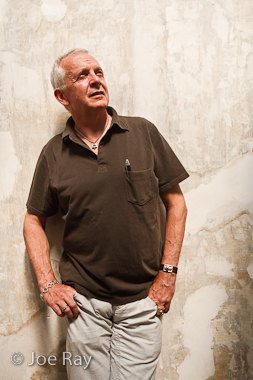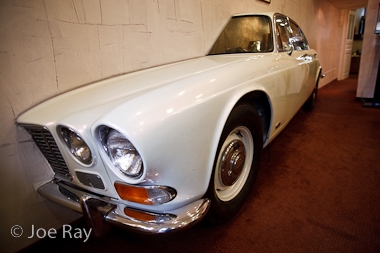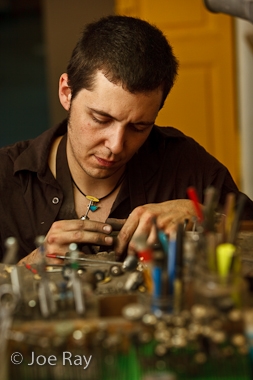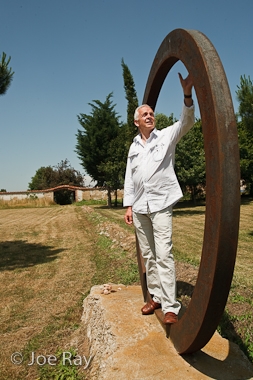Ring Road
Spring 2009 - Centurion Magazine




A traditional jeweler typically works in confined circumstances – engulfed by a crowded workbench, they create objects that, at their crudest, have limited creative potential; an engagement ring is a metal circle, a mount and a stone.
For French jeweller Philippe Tournaire (above), the idea of being confined doesn’t hold much truck and it’s rather doubtful that it ever did.
The artist, with three French boutiques and one slated for an August opening in Beijing, would rather paint with stones or build a city and put it on your finger.
“We’re not building around the stone any more,†Tournaire says of his vision of the trade. “It’s not a big stone and a big price tag that make beauty.â€
Currently, his creative juices are fuelling an architectural bent – rings that include Paris on your pinky, Rome on your ring finger. “In the beginning, jewellery was a way to show where we were or where we’d been,†he says, citing architecturally themed fourteenth-century Jewish wedding rings and north African jewellery traditions as part of his inspiration. “When I was a child, my mother would drag me around to look at architecture. As soon as she’d find out about a pile of rocks with some sort of architectural significance, we’d go.â€
“Jewellery is expensive, it’s uncomfortable and it’s not useful. It’s a gift. It’s simply something to jog your memory,†he says with droll bluntness. “The importance is in the symbol. If you ask a woman about the conditions when she received it, she can tell you about it like it was in a film.â€
The most fun in his architectural series might be Tournaire’s take on the City of Light, with Notre Dame and the all-stars of the axis made of the Louvre, Tuileries, the Place de la Concorde obelisk, the Arc de Triomphe and La Défense on a platform. Where’s the Eiffel Tower? Wrapped around your finger. La Dame de Fer is the ring itself.
Tournaire’s was not a typical career path. In 1969, he gave up an electronics repairing job to follow a dream and began making jewellery in a cave. “I liked electronics because [in a stereo] you could follow the path of a wire from the plug to the sound and find what was going wrong, but when chips got involved, I became a chip changer,†he says, “all the fun went out the window.â€
Instead, he chose another path, creating his workshop by literally digging a cave into a mountainside under his parents’ home. “It was about twice that size,†he says, motioning toward a compact Citroën in the street.
He shows me one of his first pieces – a bracelet made from a fork. “That cut down significantly on my raw material costs,†he adds with only a hint of a grin. Yet with no rent and little in the way of expenses, he could do what he wanted and kept money out of the picture.
“I was able to discover the trade myself, without constraint or someone who says ‘you’ve got to do it like this,’†he says. “There’s an inconvenience to it, but it’s also a huge opportunity.â€
Truthfully, the fork bracelet is a crude piece – the work of the beginner he was. “I didn’t even know how to weld at that point,†he says, pointing out a few rough spots, yet there’s an ingenious clasp using a tine and, based simply on the fact that he still continues to make a much sleeker version of it all these years later, a clear bit of the artist’s soul.
Fast-forward through nearly four decades of work and a meteoric rise in recognition and Tournaire still shuns working on the traditional benches called chevilles (‘ankles’), instead sitting on the basement floor next to an anvil, just like he did in his cave.
When I watch the man at work, I expect him to straddle the anvil and pound away at a ring, but instead, he plops down Indian style on the thin, unpadded carpet, takes a long pair of tweezers and a tray of jewels and starts looking at how different shades of the gems play off of one another.
“I’m painting with stones,†he says, and begins working on one of his ‘metropolis’ rings – futuristic representatives of his architecture series where the building tops create a canvas the size of a postage stamp. Without seeing it, the idea could reek of over-the-top tastelessness – a stamp’s worth of precious stones gives a lot of space to be gaudy – yet in his hands or on the right finger, it looks like a small artist’s palette where the tiny ovals, circles and geometric shapes take on a Klimt- like quality. Even here, form follows function; the highest and most exposed parts of the ring’s surface (the tops of the metropolis’ towers) are capped with diamonds that protect the softer stones below.
Futuristic creations sound funny for someone who got his start in a cave, but for Tournaire, ‘modern’ has a personal meaning. Some aspects of his method clearly follow an ‘if it ain’t broke, don’t fix it’ mentality, yet in others, he is as modern – and controversial – as they come. “We combine the archaic and the avant-garde. Some say that’s not the way it should be,†he adds, but he clearly couldn’t care less. “As soon as you’re outside of the system and succeed, the ones who follow the traditional path get a little disturbed.â€
Using his architecture series as an example, he and his team employ 3D rendering software that is eminently modern. From there, he uses a high-tech printer that uses layers of wax as ‘ink’ to build three-dimensional moulds of his creations. Indeed, many of his ideas and most of the architectural series would be impossible without the technology that he simply sees as a tool. “A computer doesn’t make something interesting or beautiful,†he counters. “It doesn’t create or give it a soul.†From here, however, he might turn a project over to his workshop where, along with modern tools, they still use others like ring clamps that appear to have been designed centuries ago.
In the shop, the apple doesn’t fall far from the tree – Tournaire’s son Mathieu now works in the workshop from Monday to Friday and on Saturdays, he comes in to do his own work and build his own personal style. “I realised that I was doing my best work at the workshop,†says Mathieu, reflecting on anthropology and history studies and working for a Lyon- based jeweller for a year. “I knew it was where I was at my best.†I ask Mathieu about the pendant he wears around his neck – it’s got more whimsy and less technique than his father’s work – but there’s also originality and a bit of soul. Is it his own creation? “Of course.â€
Like his son, Tournaire senior also wants to keep his fingers in the grease, his rear end on the basement floor and his spirit unfettered. “I hit a point where I needed to decide whether to grow the business or continue with creation,†he says of a recent turning point. When the artist tried to figure out if he needed to bring in a business partner to free him from the day-to-day operations, he let the response come from his soul. “You can be for or against things in your life,†he says, “but you’ve got to dig in.â€
Read the PDF here